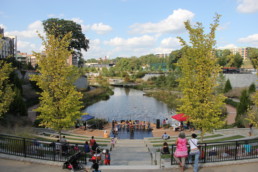Atlanta’s BeltLine is a large-scale urban mobility project that connects residents with trails and public transit while remediating land and decreasing the risk of flooding.
Atlanta’s BeltLine (ABL) is a 35.4-km transit corridor that improves mobility and addresses urban sprawl by connecting 45 inner-city neighborhoods and creating links to suburban transit systems. One of the largest and most comprehensive urban development projects in the country, the BeltLine will join 53.1 km of multi-use trail to 80.5 km of modern streetcar transportation. The Eastside Trail, a key stretch of the ABL, is designed to cater to commuters who rely on their cars for short trips in the city center. When complete in 2030, the trail is expected to reduce CO2 emissions by 123,000 metric tons from the 2014 baseline.

When constructing the Eastside Trail, the city included improvements to further benefit the community and boost resilience. For instance, it transformed a barren, contaminated site that was prone to flooding into the 6.9-hectare Historic Fourth Ward Park. The environmental remediation removed 1,700 tons of contaminated soil. The park also sports a built-in flood protection and stormwater management system.
625,000 metric tons of VMT-caused emissions will be reduced from the 2009 baseline when the project is fully implemented in 2030
The challenge
Vehicle miles traveled (VMT) is the second-largest emitter of greenhouse gases in Atlanta, responsible for 2.5 million metric tons of CO2 emissions, but, despite the city’s sprawling size, the average car trip is less than 9 km. When complete, Atlanta’s BeltLine is expected to reduce VMT emissions by up to 25% and reverse the pattern of regional sprawl, while creating vibrant, walkable, and livable communities.
Co-benefits
Economic By 2015, the ABL had created 6,100 permanent jobs, 22,490 construction jobs, and $3.1 billion in economic development.
Environmental The Atlanta BeltLine Arboretum is planting thousands of new trees across 1,300 acres and removing invasive species in the ABL.
Health The Eastside Trail promotes active modes of travel and daily physical activity that could help prevent or reduce the occurrence of cardio-vascular diseases.
Social The project is expected to add 28,000 units of housing, with 5,600 of these units classified as affordable housing.
About Atlanta
Atlanta is the capital of and the most populous city in the U.S. state of Georgia, with an estimated 2016 population of 472,522. In 1837, Atlanta was founded at the intersection of two railroad lines, and the city rose from the ashes of the American Civil War to become a national center of commerce. Today it is the primary transportation hub of the Southeastern United States, via highway, railroad, and air, with Hartsfield–Jackson Atlanta International Airport being the world’s busiest airport since 1998.


